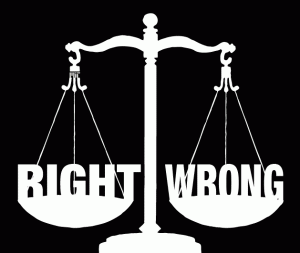
History-Social Science Curriculum:
Democratic Understanding and Civic Values

National Identity
8.1.2. Analyze the philosophy of government expressed in the Declaration of Independence, with an emphasis on government as a means of securing individual rights (e.g., key phrases such as "all men are created equal, that they are endowed by their Creator with certain unalienable rights").
8.2.2. Analyze the Articles of Confederation and the Constitution and the success of each in implementing the ideals of the Declaration of Independence.
8.4.3. Analyze the rise of capitalism and the economic problems and conflicts that accompanied it (e.g., Jackson's opposition to the National Bank; early decisions of the U.S. Supreme Court that reinforced the sanctity of contracts and a capitalistic economic system of law).

Constitutional Heritage
8.1.1 Describe the relationship between the moral and political ideas of the Great awakening and the development of revolutionary fervor.
8.2.1 Discuss the significance of the Magna Carta, the English Bill of Rights, and the Mayflower Compact.
8.2.2 Analyze the Articles of Confederation and the Constitution and the success of each in implementing the ideals of the Declaration of Independence.

Civic Values, Rights, and Responsibilities
8.2.6. Enumerate the powers of government set forth in the Constitution and the fundamental liberties ensured by the Bill of Rights.
8.2.7. Describe the principles of federalism, dual sovereignty, separation of powers, checks and balances, the nature and purpose of majority rule, and the ways in which the American idea of constitutionalism preserves individual rights.
8.3.3. Enumerate the advantages of a common market among the states as foreseen in and protected by the Constitution's clauses on interstate commerce, common coinage, and full-faith and credit.
Skills Attainment and Social Participation

Participation Skills
CCSS.ELA.Literacy.RH.6-8.2. Determine the central ideas or information of a primary or secondary source; provide and accurate summary of the source distinct from prior knowledge or opinions.
H-SS AS Students access the credibility of primary and secondary sources and draw sound conclusions from them.
CCSS. ELA. Literacy.RH.6-8.5. Describe how a text presents information (e.g., sequentially, comparatively, casually).
CCSS.ELA.Literacy.WHST.6-8.5. With some guidance and support from peers and adults, develop and strengthen writing as needed by planning, revising, editing, rewriting, or trying a new approach, focusing on how well purpose and audience have been addressed.

Critical Thinking Skills
CCSS.ELA.Literacy.RH.6-8.6 Identify aspects of a text that reveal an author's point of view or purpose (e.g., loaded language, inclusion or avoidance of particular facts).
H-SS AS Students detect the different historical points of view on historical events and determine the context in which the historical statements were made (the question asked, sources used, author's perspectives).
CCSS.ELA.Literacy.RH.6-8.8 Distinguish among facts, opinion, and reasoned judgment in a text.
H-SS AS Students distinguish among fact from opinion in historical narratives and stories.
CCSS.ELA.Literacy.WHST.6-8.9 Draw evidence from informational texts to support analysis reflection, and research.
H-SS AS Students distinguish relevant from irrelevant information, essential from incidental information, and verifiable from unverifiable in historical narratives and stories.

Basic Study Skills
CCSS.ELA.Literacy.WHST.6-8.1 Write arguments focused on discipline-specific content.
CCSS.ELA.Literacy.WHST.6-8.4 Produce clear and coherent writing in which the development, organization, and style are appropriate to task, purpose, and audience.
CCSS.ELA.Literacy.RH.6-8.1 Cite specific textual evidence to support analysis of primary and secondary sources.
H-SS AS Students assess the credibility of primary and secondary sources and draw sound conclusions from them.
United States History and Geography: Growth and Conflict-8th Grade
Knowledge and Cultural Understanding

Historical Literacy
8.1.1 Describe the relationship between the moral and political ideas of the Great Awakening and the development of revolutionary fervor.
8.2.3. Evaluate the major debates that occurred during the development of the Constitution and their ultimate resolutions in such areas as shared power among institutions, divided state-federal power, slavery, the rights of individuals and states (later addressed by the addition of the Bill of Rights), and the status of American Indian nations under the commerce clause.
8.3.4 Understand how the conflicts between Thomas Jefferson and Alexander Hamilton resulted in the emergence of two political parties (e.g., view of foreign policy, Alien and Sedition Acts, economic policy, National Bank, funding and assumption of the revolutionary debt).

Cultural Literacy
8.5.3. Outline the major treaties with American Indian nations during the administrations of the first four presidents and the varying outcomes of those treaties.
8.6.3. List the reasons for the wave of immigration from Northern Europe to the United States and describe the growth in the number, size, and spatial arrangements of cities (e.g., Irish immigrants and the Great Irish Famine).
8.8.5. Discuss Mexican settlements and their locations, cultural traditions, attitudes toward slavery, land-grant system, and economies.

Ethical Literacy
8.7.2. Trace the origins and development of slavery; its effects on black Americans and on the region's political, social, religious, economic, and cultural development; and identify the strategies that were tried to both overturn and preserve it (e.g., through the writings and historical documents on Nat Turner, Denmark Vesey).
8.7.4. Compare the lives of and opportunities for free blacks in the North with those of free blacks in the South.
8.12.6. Discuss child labor, working conditions, and laissez-faire policies toward big business and examine the labor movement, including its leaders (e.g., Samuel Gompers), its demand for collective bargaining, and its strikes and protests over labor conditions.

Geographic Literacy
8.8.4. Examine the importance of the great rivers and the struggle over water rights.
8.9.3. Describe the significance of the Northwest Ordinance in education and in the banning of slavery in new states north of the Ohio River.
8.12.1. Trace patterns of agricultural and industrial development as they relate to climate, use of natural resources, markets, and trade and locate such development on a map.

Economic Literacy
8.8.2. Describe the purpose, challenges, and economic incentives associated with Westward Expansion, including the concept of Manifest Destiny (e.g., the Lewis and Clark expedition, accounts of the removal of Indians, the cherokees' "Trail of Tears," settlement of the Great Plains) and the territorial acquisitions that spanned numerous decades.
8.12.3. Explain how states and the federal government encouraged business expansion through tariffs, banking, land grants, and subsidies.
8.12.4. Discuss entrepreneurs, industrialists, and bankers in politics, commerce, and industry (e.g., Andrew Carnegie, John D. Rockefeller, Leland Stanford).
8.12.5. Examine the location of effects of urbanization, renewed immigration, and industrialization (e.g., the effects on social fabric of cities, wealth and economic opportunities, the conservation movement).

Sociopolitical Liteacy
8.3.5. Know the significance of domestic resistance movements and ways in which the central government responded to such movements (e.g., Shay's Rebellion, the Whiskey Rebellion).
8.3.6. Describe the basic law-making process and how the Constitution provides numerous opportunities for citizens to participate in the political process and to monitor and influence government (e.g., function of elections, political parties, interest groups.
8.4.2. Explain the policy significance of famous speeches (e.g., Washington's Farewell Address, Jefferson's 1801 Inaugural Address, John Q. Adams's Fourth of July 1821 Address).